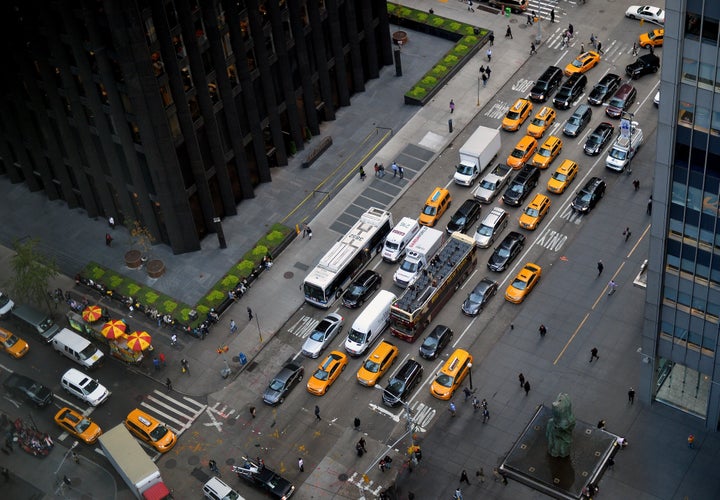
NEW YORK -- The city's streets will soon be a lot smarter.
The Big Apple will test technology allowing cars to "talk" to one another as part of a connected vehicle pilot program to improve pedestrian safety and reduce congestion and emissions. Tampa, Florida, and the state of Wyoming will also participate in the program, which is funded by a $42 million grant from the U.S. Department of Transportation.
New York will install the vehicle-to-vehicle technology in 10,000 city-run cars, buses and limos. Some infrastructure will also be outfitted with the tech, including traffic signals on First, Second, Fifth and Sixth Avenues between 14th St. and 66th St. in Manhattan, on Flatbush Avenue between Grand Army Plaza and Tillary St. in Brooklyn, and on the FDR Drive between 50th St. and 90th St. The program could cut unimpaired vehicle crashes by as much as 80 percent, transportation officials said.
The city is developing apps that would emit signals from pedestrians' cell phones; vehicles would detect the signals before a potential collision. Officials also hope to use the apps to connect those with disabilities or visual impairments with the broader signal system, including at street crossings.
"We have to work out how an app would work for the visually impaired on routes they frequently navigate, when the walk signal comes on. Not every intersection has an audible one," Polly Trottenberg, New York City's transportation commissionner, told The Huffington Post. "And not everyone has a smartphone. We need to create something so people have the app in an affordable, convenient way."
A warning system for drivers, meanwhile, might include alerts to brake or slow down before a red light, without being too loud or distracting to the person behind the wheel. Cars in a connected urban system would be able to sense one another, enabling them to travel faster and at closer distances, Trottenberg said.
If successful, the pilot program would be a huge boost to Mayor Bill de Blasio's ambitious Vision Zero campaign, which aims to eliminate traffic deaths. In the past year, the administration has reduced speed limits on busy corridors and expanded protected bike paths.
"Safety is at the top of the list," Trottenberg said. "If this technology can be realized, particularly that vehicles can sense pedestrians and cyclists faster and more accurately than the human eye, that could be profound."
The Department of Transportation first tested its connected vehicle program in 2012 in Ann Arbor, Michigan. The program relied on apps to warn drivers if a car ahead was braking, if a vehicle might be in their blind spot or if there was a red light ahead that they might quickly come upon.
But potential risks are a lot higher in a metropolis like New York than in smaller cities.
"New York is an uncontrolled urban environment," Anthony Townsend, who studies technology in cities at New York University's Rudin Center for Transportation Policy and Management and formerly led the independent nonprofit Institute for the Future, told HuffPost. "Certainly, congestion levels will be much higher, and the traffic environment is more complicated. There are more trucks, more bicycles, more pedestrians, more emergency vehicles."
The program in New York will spend a year in the design phase with the Metropolitan Transportation Authority, the Taxi and Limousine Commission and truck services. The city expects to deploy the tech-equipped vehicles in late 2016.
Officials hope to gain significant insights about smart vehicles and infrastructure through the pilot program. But the technology could raise further concerns about the security of connected vehicles, Townsend said, referencing Fiat Chrysler's decision to recall over a million Jeeps in July after discovering that hackers had remotely gained access to a vehicle's controls.
"The people working on these projects have gone to great lengths to make them more secure," Townsend noted.
Transportation officials and companies are increasingly investing in a future with automated vehicles. In July, the University of Michigan opened a fake city designed entirely to test self-driving cars and study how they will react in time to pedestrian accidents.
"We think this technology is coming, and that USDOT will mandate it in the not-too-distant future," Trottenberg said of the connected vehicles. "This could be the next exponential breakthrough in safety."
Correction: An earlier version of this story said the Institute for the Future is affiliated with New York University. It is, in fact, an independent research organization. The story also said that Anthony Townsend heads up the institute. He is the former head.
